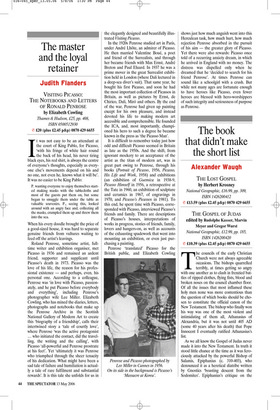The book that didn’t make the short list
Alexander Waugh
THE LOST GOSPEL by Herbert Krosney National Geographic, £16.99, pp. 309, ISBN 1426200412 ✆ £13.59 (plus £2.45 p&p) 0870 429 6655 THE GOSPEL OF JUDAS edited by Rudolphe Kasser, Marvin Meyer and Gregor Wurst National Geographic, £12.99, pp. 185, ISBN 1426200420 ✆ £10.39 (plus £2.45 p&p) 0870 429 6655 The councils of the early Christian Church were not always agreeable occasions. The bishops quarrelled terribly, at times getting so angry with one another as to clash in frenzied battles of ripped clothes, flying fists, blood and broken noses on the council chamber floor. Of all the issues that most inflamed these holy men none was more contentious than the question of which books should be chosen to constitute the official canon of the New Testament. The bishop who finally won his way was one of the most violent and intimidating of them all, Athanasius of Alexandria, but it was not until 405 AD (some 40 years after his death) that Pope Innocent I eventually ratified Athanasius’s list.
As we all know the Gospel of Judas never made it into the New Testament. In truth it stood little chance at the time as it was ferociously attacked by the powerful Bishop of Salamis, Epiphanius (c. 310-403), who denounced it as a heretical diatribe written by Gnostics ‘boasting descent from the Sodomites’. Epiphanius’s critique on the Gospel of Judas has survived in full and so too has a similar, shorter, dismissal of it by Irenaeus, Bishop of Lyons, dating from the second half of the second century, but from then onwards the text of the gospel itself disappeared — until, that is, some Egyptian peasants chanced upon an ancient copy in a casket hidden in a cave somewhere in Middle Egypt, some time around 1978. The exact details as to how, where, when and by whom this great treasure was unearthed remain obscure. What we do know is that the gospel (bound in a book with several other less valuable ancient manuscripts) somehow found its way to Cairo where it was sold to a dealer (whose name we are not allowed to know) for $2,000. That dealer, unable to decipher ancient Coptic scripts and therefore unaware that the lost Gospel of Judas was among them, clung to his bundle hoping for a trading miracle, only to discover, shortly after acquiring it, that his Cairo flat had been burgled, the Gospel stolen and secretly shipped out of Egypt.
A full version of how our mystery antiquarian recovered his property, how he then damaged it by wrapping it in newspaper and leaving it for 20 years in a damp safety deposit box in America, how the work was identified as the Judas Gospel, how it was frozen, unfrozen, secretly photographed, bought with a worthless cheque, squabbled over and finally translated into English, is told with excitable energy by the investigative journalist Herbert Krosney. Krosney is keen to spot the frauds and the gangsters and to lift the lid on low life in the fishy underworld of ancient antiquities and he does all this with contagious enthusiasm; and yet he holds back when it comes to telling his readers about the current owners of the Judas Gospel and how precisely they acquired it. All we are told is that it now belongs to a charity calling itself the Maecenas Foundation, that this body is based in Basel, and is run by a lawyer called Roberty with a passion for archaeology, whose client happened to be the previous owner. Roberty, it seems, is a really nice chap and he promises to donate the Gospel when he has finished with it to the Egyptian government. Curtain falls, happy end. Am I the only one to smell a rat?
Published simultaneously with Krosney’s investigation is the complete translated text with footnotes and four related scholarly essays. The gospel itself runs to fewer than 20 pages and, as Irenaeus and Epiphanius pointed out long ago, the text praises Judas as the most knowledgeable and inspired of the apostles who is the closest to Jesus and who, with Jesus’s connivance, hands his master over to the authorities in order that some true gnosis may be fulfilled. Jesus says to Judas with reference to the other disciples, ‘You will exceed all of them. For you will sacrifice the man that clothes me’, while the secret bond between Jesus and Judas is further amplified in Judas’s line to him: ‘I know who you are and where you have come from. You are from the immortal realm of Barbelo. And I am not worthy to utter the name of the one who has sent you.’ Judas’s Gospel may not be good enough, or even appropriate enough, for late inclusion in the New Testament canon, yet there is no doubting its venerable age. The excitement caused by its discovery has shaken the musty world of Judeo-Christian scholarship in the same way as the finds at Qumran and Nag Hammadi did in the 1940s. Roberty’s Maecenas Foundation has been artful in controlling the release of all its information. He and his team offer much to ponder upon, not least the intriguing blanks in the tale of its discovery and in the text itself. Once the ether’s wackos and conspiracy theorists have had their go, the story will no doubt get a second wind. Both books are riveting in their own right and I look forward to reading all internet appendices with equal relish.











































































 Previous page
Previous page